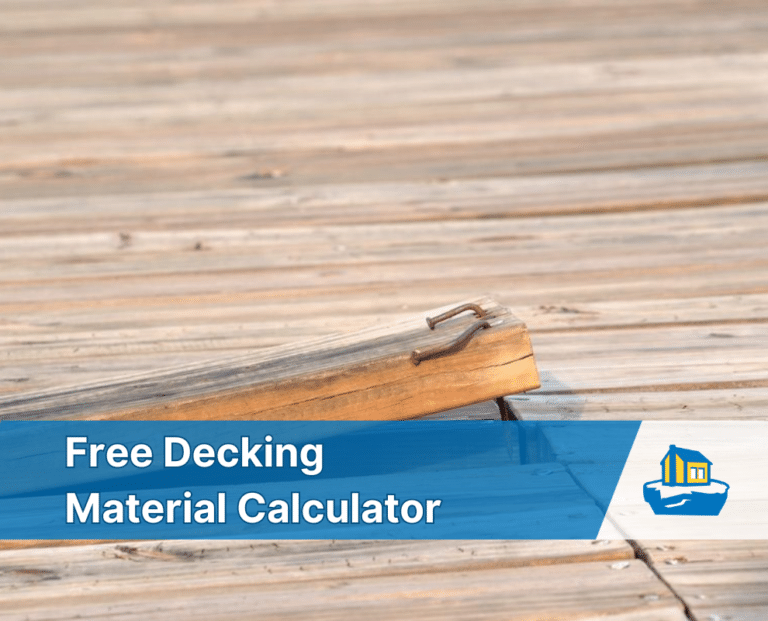4.8 1700+ Google Reviews

This decking material calculator will help you calculate the number of boards, nails, and gallons of stain needed for your new deck.
The deck cost calculator uses 2025 average prices.
The first step to knowing how much material you need is to calculate the deck area in square feet. A square deck or rectangle deck is easy. Next, multiply the length by the width of your deck. You'll need to do extra work if you have multiple shapes or a unique shape like an octagon.
The more accurate your measurements, the more accurate the decking material calculator will be.
Most decking boards are either 4" wide or 6" wide. 6" wide boards are more common. However, remember that these are nominal sizes. The actual widths of these boards are 3.5" and 5.25", respectively. This discrepancy adds up and affects the number of necessary decking boards.
Composite decking generally follows this sizing, but some brands differ. For example, some 6" composite decking is actually 5.5".
Joists are the horizontal members of the deck floor that support the decking and the loads. The most common joist spacing is 16". To measure your spacing, measure from the middle of one joist to the next.
This is important for the decking material calculator to estimate the number of screws or fasteners needed.
You'll need to know some codes before tackling your decking project. CLICK HERE FOR A FULL DECK BUILDING CODE GUIDE
First, the decking needs to be preservative treated, naturally durable such as cedar lumber, or engineered such as composite decking. In addition, you need to apply preservative treatment to any edges exposed from cutting, drilling, or notching.
Next, you need to choose the correct decking thickness. Most decking is 5/4", also expressed as 1 1/4". However, the max span for this decking is 16" when installed perpendicular to the joists. If your joists are 24" apart, you will need to upsize to 2" thick decking.
Additionally, the max span for 5/4" decking is 12" if installed diagonally to the joists. Therefore, if you are going for that look, you will likely need to upsize your decking to 2" thick. 12" deck joist spacing is not typical.
The next thing to remember is the type and number of screws used. You need two #8 corrosion-resistant screws at each joist. For example, an 8-foot board can span six joists if they are spaced 16" apart. That board will need 12 screws.
Composite decking is decking boards made of wood fibers encased in plastic.
Unlike wood, composite decking is highly resistant to rot and termites. It requires minimal maintenance and is easy to clean. The major downside to composite decking is that it's three to five times more expensive than wood. However, you do recoup that cost over time since you don't need to stain it regularly.
In other words, you spend more in the beginning. However, the actual costs between composite decking and wood decking are similar over time.
In contrast, wood decking (timber decking) is prone to rot and insect damage. It needs regular maintenance, and pressure washing removes the stain making it more difficult to clean. The upside is the lower initial cost. Plus, some people like the natural wood aesthetics.
Hidden fasteners combine screws and clips that aren't visible after installation. This gives the deck a more clean appearance and also prevents wood rot. Screws that penetrate the wood create paths for moisture.
The downside again is the cost. Even though you only need half as many hidden deck fasteners, it's still about 2-3 times more expensive than traditional screws.
NOTE: you can only use hidden deck fasteners with composite or wood decking with grooves routed in the sides. Alternatively, you can use a router or router table to create the grooves in your wood decking. Remember, though, that this means you must apply preservative treatment to these fresh edges.
The calculator assumes you are leaving 1/8" between decking boards. This gap allows the deck to drain water. If you leave a larger gap, you will need fewer boards. However, you should never use more than 1/4" gap.
The deck board calculator does not factor in your inefficiency. For example, let's say the length of your deck is 10 feet. However, the length of the board you buy from the store is 14 feet. This will lead to more waste, materials, and total costs. Instead, use the most efficient board length for your deck project to reduce the number of deck boards needed.
I hope this decking calculator helps you update your outdoor living space with minimal guesswork. Remember to be safe and don't cut corners